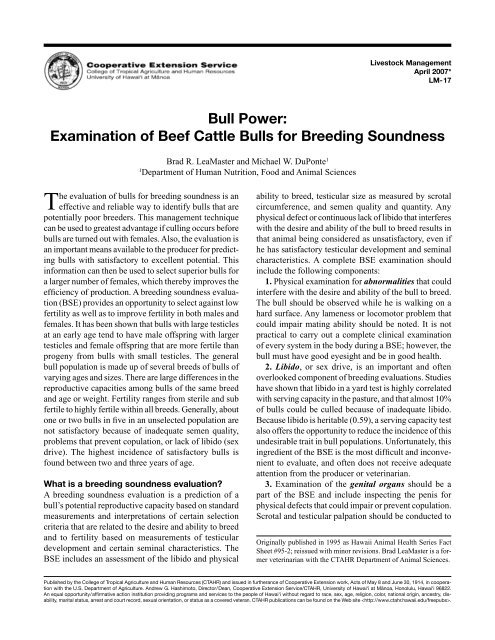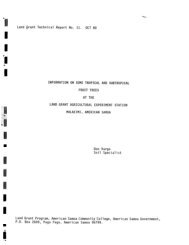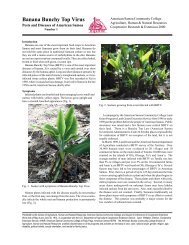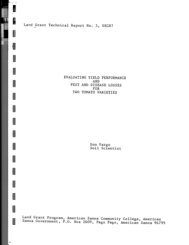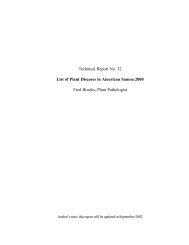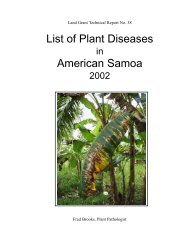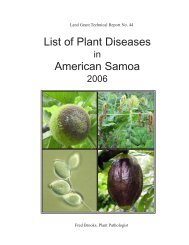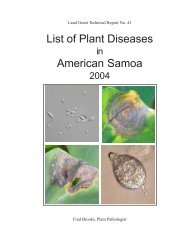Bull Power: Examination of Beef Cattle Bulls for Breeding ... - ctahr
Bull Power: Examination of Beef Cattle Bulls for Breeding ... - ctahr
Bull Power: Examination of Beef Cattle Bulls for Breeding ... - ctahr
You also want an ePaper? Increase the reach of your titles
YUMPU automatically turns print PDFs into web optimized ePapers that Google loves.
Livestock Management<br />
April 2007*<br />
LM-17<br />
<strong>Bull</strong> <strong>Power</strong>: <br />
<strong>Examination</strong> <strong>of</strong> <strong>Beef</strong> <strong>Cattle</strong> <strong>Bull</strong>s <strong>for</strong> <strong>Breeding</strong> Soundness <br />
Brad R. LeaMaster and Michael W. DuPonte 1<br />
1<br />
Department <strong>of</strong> Human Nutrition, Food and Animal Sciences<br />
The evaluation <strong>of</strong> bulls <strong>for</strong> breeding soundness is an<br />
effective and reliable way to identify bulls that are<br />
potentially poor breeders. This management technique<br />
can be used to greatest advantage if culling occurs be<strong>for</strong>e<br />
bulls are turned out with females. Also, the evaluation is<br />
an important means available to the producer <strong>for</strong> predicting<br />
bulls with satisfactory to excellent potential. This<br />
in<strong>for</strong>mation can then be used to select superior bulls <strong>for</strong><br />
a larger number <strong>of</strong> females, which thereby improves the<br />
efficiency <strong>of</strong> production. A breeding soundness evaluation<br />
(BSE) provides an opportunity to select against low<br />
fertility as well as to improve fertility in both males and<br />
females. It has been shown that bulls with large testicles<br />
at an early age tend to have male <strong>of</strong>fspring with larger<br />
testicles and female <strong>of</strong>fspring that are more fertile than<br />
progeny from bulls with small testicles. The general<br />
bull population is made up <strong>of</strong> several breeds <strong>of</strong> bulls <strong>of</strong><br />
varying ages and sizes. There are large differences in the<br />
reproductive capacities among bulls <strong>of</strong> the same breed<br />
and age or weight. Fertility ranges from sterile and sub<br />
fertile to highly fertile within all breeds. Generally, about<br />
one or two bulls in five in an unselected population are<br />
not satisfactory because <strong>of</strong> inadequate semen quality,<br />
problems that prevent copulation, or lack <strong>of</strong> libido (sex<br />
drive). The highest incidence <strong>of</strong> satisfactory bulls is<br />
found between two and three years <strong>of</strong> age.<br />
What is a breeding soundness evaluation?<br />
A breeding soundness evaluation is a prediction <strong>of</strong> a<br />
bull’s potential reproductive capacity based on standard<br />
measurements and interpretations <strong>of</strong> certain selection<br />
criteria that are related to the desire and ability to breed<br />
and to fertility based on measurements <strong>of</strong> testicular<br />
development and certain seminal characteristics. The<br />
BSE includes an assessment <strong>of</strong> the libido and physical<br />
ability to breed, testicular size as measured by scrotal<br />
circumference, and semen quality and quantity. Any<br />
physical defect or continuous lack <strong>of</strong> libido that interferes<br />
with the desire and ability <strong>of</strong> the bull to breed results in<br />
that animal being considered as unsatisfactory, even if<br />
he has satisfactory testicular development and seminal<br />
characteristics. A complete BSE examination should<br />
include the following components:<br />
1. Physical examination <strong>for</strong> abnormalities that could<br />
interfere with the desire and ability <strong>of</strong> the bull to breed.<br />
The bull should be observed while he is walking on a<br />
hard surface. Any lameness or locomotor problem that<br />
could impair mating ability should be noted. It is not<br />
practical to carry out a complete clinical examination<br />
<strong>of</strong> every system in the body during a BSE; however, the<br />
bull must have good eyesight and be in good health.<br />
2. Libido, or sex drive, is an important and <strong>of</strong>ten<br />
overlooked component <strong>of</strong> breeding evaluations. Studies<br />
have shown that libido in a yard test is highly correlated<br />
with serving capacity in the pasture, and that almost 10%<br />
<strong>of</strong> bulls could be culled because <strong>of</strong> inadequate libido.<br />
Because libido is heritable (0.59), a serving capacity test<br />
also <strong>of</strong>fers the opportunity to reduce the incidence <strong>of</strong> this<br />
undesirable trait in bull populations. Un<strong>for</strong>tunately, this<br />
ingredient <strong>of</strong> the BSE is the most difficult and inconvenient<br />
to evaluate, and <strong>of</strong>ten does not receive adequate<br />
attention from the producer or veterinarian.<br />
3. <strong>Examination</strong> <strong>of</strong> the genital organs should be a<br />
part <strong>of</strong> the BSE and include inspecting the penis <strong>for</strong><br />
physical defects that could impair or prevent copulation.<br />
Scrotal and testicular palpation should be conducted to<br />
Originally published in 1995 as Hawaii Animal Health Series Fact<br />
Sheet #95-2; reissued with minor revisions. Brad LeaMaster is a <strong>for</strong>mer<br />
veterinarian with the CTAHR Department <strong>of</strong> Animal Sciences.<br />
Published by the College <strong>of</strong> Tropical Agriculture and Human Resources (CTAHR) and issued in furtherance <strong>of</strong> Cooperative Extension work, Acts <strong>of</strong> May 8 and June 30, 1914, in cooperation<br />
with the U.S. Department <strong>of</strong> Agriculture. Andrew G. Hashimoto, Director/Dean, Cooperative Extension Service/CTAHR, University <strong>of</strong> Hawai‘i at Mänoa, Honolulu, Hawai‘i 96822.<br />
An equal opportunity/affirmative action institution providing programs and services to the people <strong>of</strong> Hawai‘i without regard to race, sex, age, religion, color, national origin, ancestry, disability,<br />
marital status, arrest and court record, sexual orientation, or status as a covered veteran. CTAHR publications can be found on the Web site .
UH–CTAHR <strong>Bull</strong> <strong>Power</strong>: LM-17 — Apr. 2007<br />
detect any abnormalities which might have an effect on<br />
fertility. Common abnormalities include small testicles,<br />
s<strong>of</strong>t testicles, difference in the size <strong>of</strong> testicles, scrotal<br />
hernia, scrotal dermatitis, cryptorchids (high flankers),<br />
and palpable epididymal conditions.<br />
A rectal examination should be per<strong>for</strong>med by a veterinarian<br />
and include palpation <strong>of</strong> the pelvic urethra,<br />
prostrate, vesicular glands, ampullae, vas deferens, and<br />
internal inguinal rings. The most common abnormal<br />
finding associated with the internal genital organs is<br />
seminal vesiculitis.<br />
4. Scrotal circumference measurement is easy to<br />
per<strong>for</strong>m and contributes important in<strong>for</strong>mation to the<br />
BSE. <strong>Bull</strong>s with a large scrotal circumference (as a<br />
reflection <strong>of</strong> large testicles) produce more semen, have<br />
a higher prevalence <strong>of</strong> normal sperm, and have greater<br />
sperm motility than bulls with small scrotal circumference.<br />
In beef cattle, there is a high correlation between<br />
scrotal circumference measurements in bulls and the age<br />
at which female progeny reach puberty. Females from<br />
sires with above average testicle size reach puberty at an<br />
earlier age. Selection based on scrotal circumference <strong>of</strong>fers<br />
another opportunity to improve fertility in herds.<br />
5. Semen evaluation. Sperm motility and morphology<br />
are the seminal characteristics that are most highly<br />
correlated with fertility and are the most easily repeated.<br />
Characteristics such as volume, concentration, and<br />
percentage alive are no longer used as scoring criteria<br />
because there is a low correlation with fertility and because<br />
repeatability within bulls and between ejaculates<br />
is poor, especially in electroejaculated samples.<br />
When to evaluate bulls<br />
Sires may be evaluated at any number <strong>of</strong> times and as<br />
<strong>of</strong>ten as desired. Evaluation just prior to the breeding<br />
season has the advantage that the evaluation indicates<br />
breeding ability at the time nearest the time <strong>of</strong> use. Males<br />
are normally gathered at this time <strong>for</strong> observation, so unnecessary<br />
labor and stress are eliminated.Adisadvantage<br />
<strong>of</strong> testing just prior to the breeding season is acquiring<br />
replacements. If several bulls are unsatisfactory it may<br />
be difficult to find replacements <strong>of</strong> the desired quality.<br />
Evaluation during the <strong>of</strong>f season when bulls are plentiful<br />
<strong>of</strong>fers an excellent opportunity to purchase new sires.<br />
Prices should be best at this time. The disadvantage is<br />
that the bull selected may injure himself or become<br />
sick between the time <strong>of</strong> evaluation and the breeding<br />
season.<br />
Occasionally, a producer conducts a BSE during the<br />
breeding season to determine if the sire is keeping his<br />
sperm production up while breeding the herd. Evaluation<br />
is done after three to four weeks into the breeding season.<br />
By this time all females should have been in estrus, and<br />
the bull should have had the opportunity <strong>of</strong> breeding<br />
each. The presence <strong>of</strong> poor quality semen at this time<br />
would indicate overuse. The bull should be rested and a<br />
replacement selected.<br />
A BSE at the end <strong>of</strong> the breeding season is <strong>of</strong> little<br />
value to the current breeding season; however, it does<br />
allow the producer an opportunity to eliminate any undesirable<br />
bulls so they will not be carried over several<br />
months without any economic return.<br />
<strong>Bull</strong>s may be tested anytime there may be a doubt<br />
or question regarding a bull’s fertility. For example,<br />
if females continue to recycle, indicating they are not<br />
bred, then the bull that is supposed to be breeding them<br />
should be examined. This could be done at any time the<br />
producer desires, with adjustments made accordingly.<br />
A veterinarian is not required to be present <strong>for</strong> all <strong>of</strong><br />
the segments <strong>of</strong> the BSE. For example, the evaluation<br />
<strong>of</strong> the social interaction <strong>of</strong> the bull among other bulls<br />
and its libido and ability to breed can be done by the<br />
producer, thereby saving money.<br />
Benefits <strong>of</strong> a BSE<br />
Research studies have shown that when bulls were given<br />
a BSE prior to breeding, as compared to none in previous<br />
years, the pregnancy rate increased by 3.5%, the breeding<br />
season was shortened, calf weaning weights increased,<br />
and the bull-to-cow ratio increased from 1:20 to 1:30.<br />
References<br />
Sorensen, A.M. 1979. Animal reproduction principles<br />
and practices. McGraw-Hill Book Company, New<br />
York. p. 110–146.<br />
Radostits, O.M., K.E. Leslie, and J. Fetrow. 1994.<br />
Planned animal health and production in beef cattle<br />
breeding herds. In: Herd health: Food animal production<br />
medicine. 2nd edition. W.B. Saunders Company,<br />
Philadelphia. p. 331–393.<br />
Acknowledgement<br />
The authors extend their thanks and appreciation to Mr.<br />
Victor Groves <strong>for</strong> graphics and technical services.<br />
2
UH–CTAHR <strong>Examination</strong> <strong>of</strong> <strong>Beef</strong> <strong>Cattle</strong> <strong>Bull</strong>s <strong>for</strong> <strong>Breeding</strong> Soundness LM-17 — Apr. 2007<br />
Table 1. Sample BSE scoring system<br />
Scrotal circumference (cm)<br />
Age (months)<br />
Rating 12–14 15–20 21–30 >30 Score<br />
Good >35 >37 >39 >40 40<br />
Fair 30–35 31–37 32–39 33–40 24<br />
Poor


